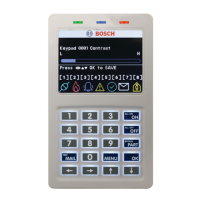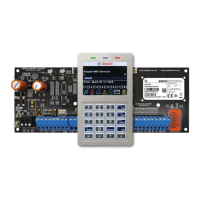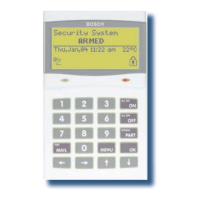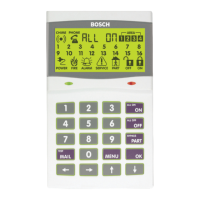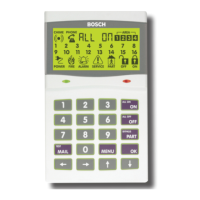Do you have a question about the Bosch SOLUTION 6000 and is the answer not in the manual?
Lists the main features of the Solution 6000 control panel.
Defines what a zone is and its identification within the system.
Describes the status of a zone when a door or window is open.
Explains the two basic types of zones: Non 24-hour and 24-hour.
Describes zones that remain unarmed when the system is armed.
Zones that are always active and cannot be turned off.
Explains how the system can be divided into up to 8 individual areas.
Explains the keypad's layout, buttons, and their functions.
Detailed descriptions of each keypad button and its function.
Explanation of status icons and indicator lights on the keypad.
Description of different tones emitted by the keypad for alerts.
How to arm an area completely, including all non 24-hour zones.
How to arm only a portion of an area, based on programming.
Procedure for disarming the security system.
How to silence an active alarm and clear alarm memory.
How the system automatically arms itself at set times.
How to arm the system remotely using a telephone.
Using DTMF tones for remote system control and operations.
How to trigger a duress or silent panic alarm if forced.
Instructions for entering text and names via the keypad.
Procedure for removing a user's data from the system.
How to change your personal PIN code.
How a master user changes another user's PIN.
How a master user adds a PIN for a new user.
How a master user deletes another user's PIN.
Information on using token cards for system access.
How to add a new token card for a user.
How to remove a token card assigned to a user.
How to identify programmed tokens and their assignments.
How to modify a user's existing token information.
Instructions for adding and deleting RF keyfobs for access.
How to program a user's RF keyfob ID number.
How to remove a user's RF keyfob ID.
How to program a descriptive name for each user.
Assigning users to specific system areas for access control.
Configuring various system options for individual users.
Explains how TimeZones restrict user access based on time/day.
Assigning users to control access to specific doors or outputs.
Setting an expiry date for user credentials, disabling access.
Details on using the fingerprint reader for system access.
Procedure to enroll a new fingerprint for a user.
Procedure to remove a user's enrolled fingerprint.
How to identify which user an enrolled fingerprint belongs to.
How to simultaneously arm all assigned areas.
How to individually arm or disarm a specific area.
How to simultaneously disarm all assigned areas.
Switching the keypad's operational area context.
Enabling or disabling the chime function for an area.
Setting how the chime alert sounds when triggered.
Programming a custom name for each system area.
Naming the first part mode configuration for an area.
Naming the second part mode configuration for an area.
Programming automatic arming times for areas via timezones.
Setting the duration to leave after arming an area.
Setting the first delay period for disarming an area.
Setting the second delay period for disarming an area.
Setting the time allowed to disarm after a Part On/Part 2 On fault.
Viewing the current operational status of individual zones.
Viewing zones in groups, displaying their status.
Disabling specific zones temporarily before arming.
Programming zones to trigger chime alerts when open.
Programming which zones are monitored in Part 2 On mode.
Resetting smoke detectors after an event.
Programming descriptive names for each zone.
Testing all zones within an area simultaneously by opening/closing.
Testing a specific zone by simulating an open/close event.
Manually controlling programmed outputs like lights or gates.
Viewing the status of outputs in groups of 16.
Viewing the current status of a specific door (locked, unlocked).
Viewing the status of multiple doors on the system.
Manually overriding the normal locked/unlocked state of a door.
Programming descriptive names for system outputs.
Programming descriptive names for system doors.
Testing the functionality of external sirens.
Testing the functionality of internal sirens.
Testing the external strobe light function.
Testing the fire sirens connected to the system.
Enabling or disabling the call forwarding feature.
Programming primary phone numbers for alarm reports.
Programming secondary phone numbers for alarm reports.
Programming the sequence to automatically divert calls when armed.
Programming the sequence to cancel call diversion when disarmed.
Setting the RAS security PIN for remote access and configuration.
Programming the email address for receiving system reports.
Selecting which event types are reported via email.
Manually sending a test report to verify communication functions.
Adjusting the audible volume of the keypad's buzzer.
Adjusting the display contrast for better readability.
Adjusting the brightness of the keypad's LCD backlight.
Programming numbers to trigger outputs via incoming calls.
Selecting phones allowed to send SMS commands to the system.
Viewing panel software version and active system troubles.
Listing and interpreting all current system trouble events.
Accessing and reviewing recorded system events and reports.
Viewing the active/inactive status of all configured timezones.
Programming and adjusting the system's date and time.
Adjusting the volume level for siren beeps.
Programming which days of the week a timezone is active.
Selecting various operational options for timezones.
Programming the start and stop dates for holiday periods.
Setting minimum and maximum temperatures for keypad monitoring.
Manually testing the system's backup battery performance.
Lists the main features of the Solution 6000 control panel.
Defines what a zone is and its identification within the system.
Describes the status of a zone when a door or window is open.
Explains the two basic types of zones: Non 24-hour and 24-hour.
Describes zones that remain unarmed when the system is armed.
Zones that are always active and cannot be turned off.
Explains how the system can be divided into up to 8 individual areas.
Explains the keypad's layout, buttons, and their functions.
Detailed descriptions of each keypad button and its function.
Explanation of status icons and indicator lights on the keypad.
Description of different tones emitted by the keypad for alerts.
How to arm an area completely, including all non 24-hour zones.
How to arm only a portion of an area, based on programming.
Procedure for disarming the security system.
How to silence an active alarm and clear alarm memory.
How the system automatically arms itself at set times.
How to arm the system remotely using a telephone.
Using DTMF tones for remote system control and operations.
How to trigger a duress or silent panic alarm if forced.
Instructions for entering text and names via the keypad.
Procedure for removing a user's data from the system.
How to change your personal PIN code.
How a master user changes another user's PIN.
How a master user adds a PIN for a new user.
How a master user deletes another user's PIN.
Information on using token cards for system access.
How to add a new token card for a user.
How to remove a token card assigned to a user.
How to identify programmed tokens and their assignments.
How to modify a user's existing token information.
Instructions for adding and deleting RF keyfobs for access.
How to program a user's RF keyfob ID number.
How to remove a user's RF keyfob ID.
How to program a descriptive name for each user.
Assigning users to specific system areas for access control.
Configuring various system options for individual users.
Explains how TimeZones restrict user access based on time/day.
Assigning users to control access to specific doors or outputs.
Setting an expiry date for user credentials, disabling access.
Details on using the fingerprint reader for system access.
Procedure to enroll a new fingerprint for a user.
Procedure to remove a user's enrolled fingerprint.
How to identify which user an enrolled fingerprint belongs to.
How to simultaneously arm all assigned areas.
How to individually arm or disarm a specific area.
How to simultaneously disarm all assigned areas.
Switching the keypad's operational area context.
Enabling or disabling the chime function for an area.
Setting how the chime alert sounds when triggered.
Programming a custom name for each system area.
Naming the first part mode configuration for an area.
Naming the second part mode configuration for an area.
Programming automatic arming times for areas via timezones.
Setting the duration to leave after arming an area.
Setting the first delay period for disarming an area.
Setting the second delay period for disarming an area.
Setting the time allowed to disarm after a Part On/Part 2 On fault.
Viewing the current operational status of individual zones.
Viewing zones in groups, displaying their status.
Disabling specific zones temporarily before arming.
Programming zones to trigger chime alerts when open.
Programming which zones are monitored in Part 2 On mode.
Resetting smoke detectors after an event.
Programming descriptive names for each zone.
Testing all zones within an area simultaneously by opening/closing.
Testing a specific zone by simulating an open/close event.
Manually controlling programmed outputs like lights or gates.
Viewing the status of outputs in groups of 16.
Viewing the current status of a specific door (locked, unlocked).
Viewing the status of multiple doors on the system.
Manually overriding the normal locked/unlocked state of a door.
Programming descriptive names for system outputs.
Programming descriptive names for system doors.
Testing the functionality of external sirens.
Testing the functionality of internal sirens.
Testing the external strobe light function.
Testing the fire sirens connected to the system.
Enabling or disabling the call forwarding feature.
Programming primary phone numbers for alarm reports.
Programming secondary phone numbers for alarm reports.
Programming the sequence to automatically divert calls when armed.
Programming the sequence to cancel call diversion when disarmed.
Setting the RAS security PIN for remote access and configuration.
Programming the email address for receiving system reports.
Selecting which event types are reported via email.
Manually sending a test report to verify communication functions.
Adjusting the audible volume of the keypad's buzzer.
Adjusting the display contrast for better readability.
Adjusting the brightness of the keypad's LCD backlight.
Programming numbers to trigger outputs via incoming calls.
Selecting phones allowed to send SMS commands to the system.
Viewing panel software version and active system troubles.
Listing and interpreting all current system trouble events.
Accessing and reviewing recorded system events and reports.
Viewing the active/inactive status of all configured timezones.
Programming and adjusting the system's date and time.
Adjusting the volume level for siren beeps.
Programming which days of the week a timezone is active.
Selecting various operational options for timezones.
Programming the start and stop dates for holiday periods.
Setting minimum and maximum temperatures for keypad monitoring.
Manually testing the system's backup battery performance.
| Partitions | 8 |
|---|---|
| System Type | Hybrid wired/wireless security system |
| Keypads | Up to 16 |
| Communication | PSTN, optional IP module, optional GSM/GPRS module |
| Arming Modes | Stay, Away |
| Power Supply | 16.5VAC |
| Backup Battery | 12V 7Ah |
| Operating Temperature | 0°C to +50°C |
